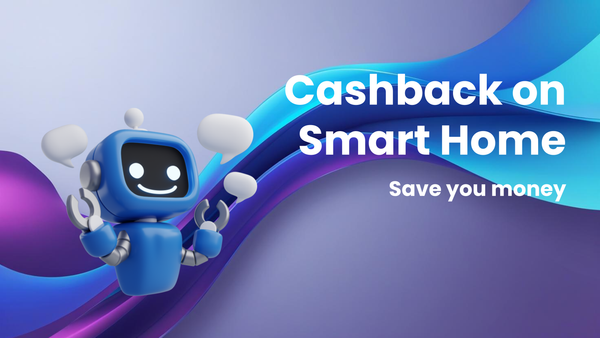How to Use Price Tracking on Smartphones to Improve Cashback Stacking

Level Up Your Savings: How to Use Price Tracking on Smartphones to Master Cashback Stacking
Imagine buying that gadget you’ve been eyeing for months, not only at a significantly lower price but also earning a substantial chunk of cashback on top. Sounds too good to be true? It’s not. The secret lies in strategically combining price tracking on your smartphone with the art of cashback stacking.
This isn't just about clipping coupons; it's about leveraging technology and understanding the intricacies of retail promotions to maximize your savings. Many people miss out on significant savings simply because they don't know how to effectively combine these two powerful tools. They might impulsively buy something when it's "on sale" without verifying if it's truly the best price, or they might forget to activate cashback offers, leaving money on the table.
This article will guide you through the world of price tracking and cashback stacking, revealing how you can use your smartphone to become a savvier shopper. We'll explore the intricacies of each concept, demonstrate how they work together, and equip you with practical strategies to significantly boost your savings. Get ready to transform your shopping habits and unlock a new level of financial empowerment.
Understanding the Power of Price Tracking
Price tracking, at its core, is the process of monitoring the price fluctuations of a product or service over time. It allows you to identify patterns, anticipate price drops, and ultimately purchase items when they are at their lowest. Why is this important? Because the advertised "sale" price isn't always the lowest price.
The concept of price tracking isn't new. Savvy shoppers have been comparing prices across different stores for decades, using flyers, newspaper ads, and word-of-mouth recommendations. However, the advent of smartphones and specialized apps has made price tracking significantly easier and more efficient. Now, instead of manually checking multiple sources, you can set up automated price alerts and receive notifications when a product reaches your desired price point.
Think of it like this: you want to buy a new 4K television. Instead of rushing to the store when you see a "20% off" sign, you use a price tracking app to monitor its price across different retailers. Over a few weeks, you notice that the price fluctuates, often dipping lower than the initial "20% off" sale price. By waiting for the optimal moment, you could potentially save significantly more money.
The benefits of price tracking extend beyond just finding the lowest price. It also helps you:
- Avoid impulse purchases: By tracking prices over time, you become more aware of the true value of a product and less susceptible to marketing hype.
- Identify genuine deals: Price tracking reveals whether a "sale" is actually a price reduction or just a temporary promotion designed to create a false sense of urgency.
- Make informed decisions: Armed with historical price data, you can confidently assess whether a product is worth buying at its current price or whether you should wait for a further price drop.
However, price tracking isn't without its challenges.
One common mistake is relying solely on a single price tracking app or retailer. Different apps may have different data sources, and some retailers may not be included in all price tracking services. To get a comprehensive view of price fluctuations, it's best to use multiple apps and compare prices across different retailers.
Another challenge is dealing with dynamic pricing, where retailers adjust prices based on factors like demand, competitor pricing, and even your browsing history. This can make it difficult to predict future price movements. To mitigate this, try clearing your browser cookies and using a VPN to mask your location when tracking prices.
Decoding Cashback Stacking: Multiply Your Rewards
Cashback stacking is the art of combining multiple cashback offers and rewards programs to maximize your earnings on a single purchase. It's like layering discounts on top of each other, creating a multiplier effect that can significantly reduce the overall cost of your purchase.
The idea behind cashback stacking is simple: leverage every available opportunity to earn rewards on your spending. This can involve using cashback credit cards, shopping through cashback portals, utilizing retailer-specific rewards programs, and even taking advantage of manufacturer rebates.
Let's say you want to buy a new laptop online. Here's how you could potentially stack cashback offers:
- Start with a cashback portal: Before visiting the retailer's website, go through a cashback portal like Rakuten or TopCashback. These portals partner with thousands of retailers and offer a percentage of your purchase back as cashback. Let's assume the portal offers 5% cashback at your chosen retailer.
- Use a cashback credit card: Pay for your purchase using a credit card that offers cashback rewards. If your card offers 2% cashback on all purchases, you'll earn an additional 2% back.
- Redeem retailer rewards: Check if the retailer has its own rewards program. If so, activate any available offers or redeem points for additional discounts.
- Look for manufacturer rebates: After your purchase, check if the manufacturer is offering any rebates. These are often available on electronics, appliances, and other high-value items.
By combining these four strategies, you could potentially earn a significant amount of cashback on your laptop purchase. Instead of just paying the full price, you're essentially getting paid to shop.
The beauty of cashback stacking lies in its flexibility. You can tailor your approach based on the specific retailer, product, and available offers. However, it's important to be organized and keep track of all your different cashback accounts and rewards programs.
One common mistake is failing to read the terms and conditions of each offer. Some cashback portals may exclude certain products or categories from earning cashback. Similarly, some credit cards may have spending limits or restrictions on cashback rewards. Always read the fine print to ensure you're maximizing your earnings.
Another challenge is managing multiple accounts and passwords. To simplify this, consider using a password manager and creating a spreadsheet to track your cashback balances and expiration dates.
The Synergy: Combining Price Tracking and Cashback Stacking
Now that you understand the power of price tracking and cashback stacking individually, let's explore how you can combine them to achieve even greater savings. The key is to use price tracking to identify the optimal time to buy, and then use cashback stacking to maximize your rewards on that purchase.
Here's a step-by-step guide to effectively combining these two strategies:
- Identify the product you want to buy: Start by identifying the specific product you're interested in purchasing.
- Set up price tracking: Use a price tracking app or website to monitor the price of the product across different retailers. Set up alerts to be notified when the price drops to your desired level.
- Research cashback offers: While you're tracking the price, research available cashback offers for that product or retailer. Check cashback portals, credit card rewards programs, retailer-specific programs, and manufacturer rebates.
- Wait for the optimal moment: Be patient and wait for the price to drop to your desired level. This may take days, weeks, or even months, but the savings will be worth it.
- Activate cashback offers: Once the price reaches your target, activate all available cashback offers before making your purchase. This may involve clicking through a cashback portal, activating a credit card offer, or enrolling in a retailer rewards program.
- Make your purchase: Complete your purchase using your chosen method, ensuring that all cashback offers are properly activated.
- Track your rewards: After your purchase, track your cashback earnings and ensure that they are properly credited to your accounts.
- Redeem your rewards: Once you've accumulated enough cashback, redeem your rewards for cash, gift cards, or other valuable benefits.
Let's illustrate this with an example: You want to buy a new smartphone.
- Price Tracking: You use an app like CamelCamelCamel (for Amazon) or Google Shopping to track the price of the specific model you want across multiple retailers. You set an alert for when the price drops below $800.
- Cashback Research: You check Rakuten, TopCashback, and your credit card rewards program. Rakuten is offering 8% cashback at the retailer with the lowest tracked price, and your credit card offers an additional 2% cashback on online purchases.
- The Drop: After two weeks, you receive a price alert: the smartphone is now $799 at your chosen retailer.
- Stacking Activation: You click through Rakuten to activate the 8% cashback, then use your cashback credit card to make the purchase.
- The Result: You get the smartphone for $799, plus 8% cashback from Rakuten (approximately $64) and 2% cashback from your credit card (approximately $16), for a total savings of $80.
By combining price tracking and cashback stacking, you've effectively reduced the cost of your smartphone by $80, without sacrificing quality or convenience.
Of course, there are potential challenges.
One hurdle is dealing with limited-time offers. Cashback portals often run promotions that offer increased cashback rates for a limited time. If you see a particularly lucrative offer, you may be tempted to make a purchase even if the price isn't at its absolute lowest. In these situations, it's important to weigh the potential savings from the increased cashback against the potential savings from waiting for a lower price.
Another challenge is dealing with fluctuating cashback rates. Cashback portals can change their rates at any time, so it's important to check the current rates before making your purchase. To mitigate this, consider using a cashback comparison tool like Cashback Monitor, which tracks cashback rates across different portals and alerts you to the best available offers.
Navigating the Ethical Considerations
While price tracking and cashback stacking are perfectly legal and ethical ways to save money, it's important to be mindful of potential ethical considerations.
One potential issue is the use of deceptive marketing practices. Some retailers may artificially inflate their prices before offering a "discount," creating a false sense of value. As a savvy shopper, it's your responsibility to be aware of these tactics and make informed decisions based on historical price data.
Another potential issue is the exploitation of loopholes in cashback programs. Some individuals may attempt to manipulate the system to earn excessive cashback, such as by creating multiple accounts or making fraudulent purchases. This can harm the integrity of the programs and potentially lead to legal consequences. It's important to play by the rules and use cashback programs in a responsible and ethical manner.
A balanced approach is crucial. Aim for maximizing savings through legitimate strategies, rather than exploiting potential loopholes. Consider supporting retailers that offer fair prices and transparent cashback programs.
Smartphone Apps: Your Price Tracking and Cashback Stacking Toolkit
Numerous smartphone apps can help you track prices and manage cashback offers. Here are some of the most popular and effective options:
Price Tracking Apps:
- CamelCamelCamel: Specifically for Amazon, this app tracks price history and sends alerts for price drops.
- Google Shopping: Allows you to compare prices across multiple retailers and set price alerts.
- ShopSavvy: Scans barcodes and compares prices in local stores and online.
- Honey: A browser extension and app that automatically finds and applies coupons and promo codes.
Cashback Apps:
- Rakuten (formerly Ebates): Offers cashback at thousands of retailers through their website and app.
- TopCashback: Similar to Rakuten, offering cashback at a wide range of retailers.
- Ibotta: Focuses on grocery and household items, offering cashback through receipt scanning and linking loyalty accounts.
- Dosh: Automatically earns cashback when you shop at participating retailers using a linked credit card.
Tips for using these apps effectively:
- Customize alerts: Set specific price targets and frequency of notifications to avoid being overwhelmed.
- Compare data: Use multiple apps to get a comprehensive view of prices and cashback offers.
- Read reviews: Check app reviews and ratings to ensure reliability and user satisfaction.
- Stay updated: Regularly update your apps to benefit from the latest features and security updates.
Beyond the Basics: Advanced Strategies for Maximizing Savings
Once you've mastered the fundamentals of price tracking and cashback stacking, you can explore some advanced strategies to further maximize your savings:
- Price matching: Take advantage of retailers' price matching policies. If you find a lower price at a competitor, many retailers will match that price.
- Open box deals: Consider buying open box or refurbished items, which are often available at significant discounts.
- Credit card rewards optimization: Choose credit cards that offer bonus rewards in categories where you spend the most money.
- Gift card arbitrage: Buy discounted gift cards and use them to make purchases, effectively stacking the discount with other cashback offers.
- Timing your purchases: Shop during seasonal sales events like Black Friday, Cyber Monday, and back-to-school sales.
- Utilize browser extensions: Install browser extensions like Honey and Rakuten, which automatically find and apply coupons and cashback offers while you shop online.
By implementing these advanced strategies, you can transform your shopping habits and unlock even greater savings.
Price tracking and cashback stacking, when used strategically, are powerful tools for savvy shoppers. They require a bit of patience, research, and organization, but the rewards can be significant.
The Future of Savings: What's Next?
The landscape of price tracking and cashback is constantly evolving, driven by technological advancements and changing consumer behavior. Here are some trends to watch out for:
- AI-powered shopping assistants: Artificial intelligence is being used to develop shopping assistants that can automatically track prices, find coupons, and stack cashback offers.
- Personalized offers: Retailers are increasingly using data analytics to offer personalized discounts and cashback offers based on your browsing history and purchase behavior.
- Cryptocurrency rewards: Some companies are offering cashback in the form of cryptocurrencies, providing an alternative to traditional cash or gift cards.
- Integration with smart home devices: Imagine your smart home device automatically tracking prices and alerting you to deals on items you need.
By staying informed about these trends, you can continue to adapt your strategies and maximize your savings in the years to come.
Conclusion: Take Control of Your Spending
Price tracking on your smartphone, combined with strategic cashback stacking, empowers you to take control of your spending and make informed purchasing decisions. It transforms you from a passive consumer into an active participant in the retail market, allowing you to leverage technology and knowledge to maximize your savings.
The key takeaway is that saving money isn't about deprivation; it's about making smart choices and leveraging available resources. By mastering the art of price tracking and cashback stacking, you can achieve your financial goals faster and enjoy the things you want without breaking the bank.
Now, take action. Download a price tracking app, research cashback offers, and start tracking the prices of items you're interested in buying. Experiment with different strategies and find what works best for you. The more you practice, the better you'll become at maximizing your savings. And who knows, you might even inspire your friends and family to join the savings revolution.
Consider exploring another article on building and sticking to a budget. By building a budget and combining that skill with the ability to track prices and earn cashback, you’ll have even more control over your finances.




